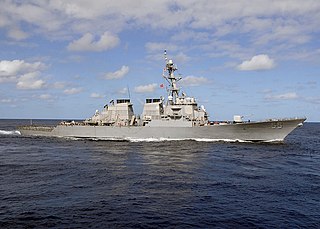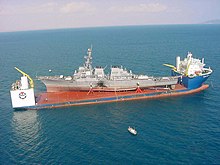
The USS Cole bombing was a suicide attack by al-Qaeda against USS Cole, a guided missile destroyer of the United States Navy, on 12 October 2000, while she was being refueled in Yemen's Aden harbor.

USS Dwight D. Eisenhower (CVN-69) is a nuclear-powered aircraft carrier currently in service with the United States Navy. Commissioned in 1977, the ship is the second of the ten Nimitz-class aircraft carriers currently in service, and is the first ship named after the 34th President of the United States and General of the Army Dwight D. Eisenhower. The vessel was initially named simply as USS Eisenhower, much like the lead ship of the class, Nimitz, but the name was changed to its present form on 25 May 1970. The carrier, like all others of her class, was constructed at Newport News Shipbuilding Company in Virginia, with the same design as the lead ship, although the ship has been overhauled twice to bring her up to the standards of those constructed more recently.

The Arleigh Burke class of guided-missile destroyers (DDGs) is a United States Navy class of destroyer centered around the Aegis Combat System and the SPY-1D multi-function passive electronically scanned array radar. The class is named for Admiral Arleigh Burke, an American destroyer officer in World War II and later Chief of Naval Operations. With an overall length of 505 to 509.5 feet, displacement ranging from 8,300 to 9,700 tons, and weaponry including over 90 missiles, the Arleigh Burke-class destroyers are larger and more heavily armed than many previous classes of guided-missile cruisers.

USS Ramage (DDG-61) is an Arleigh Burke-class guided missile destroyer of the United States Navy. The ship is named for Vice Admiral Lawson P. Ramage, a notable submarine commander and Medal of Honor recipient in World War II.

USS Decatur (DDG-73) is an Arleigh Burke-class destroyer in the United States Navy. She is named for the former naval officer Stephen Decatur, Jr. This ship is the 22nd destroyer of her class. USS Decatur was the 13th ship of this class to be built at Bath Iron Works in Bath, Maine, and construction began on 11 January 1996. She was launched on 10 November 1996 and was christened on 8 November 1996. On 29 August 1998 she was commissioned at the Tom McCall Waterfront Park in Portland, Oregon.

USS Arleigh Burke (DDG-51), named for Admiral Arleigh A. Burke, USN (1901–1996), is the lead ship of the Arleigh Burke-class guided-missile destroyers. She was laid down by the Bath Iron Works company at Bath, Maine, on 6 December 1988; launched on 16 September 1989; and commissioned on 4 July 1991.

USS The Sullivans (DDG-68) is an Arleigh Burke-class Aegis guided missile destroyer. She is the second ship of the United States Navy to be named for the five Sullivan brothers–George, Francis, Joseph, Madison, and Albert Sullivan, aged 20 to 27–who died when their ship, USS Juneau, was sunk by a Japanese submarine in November 1942 in the Naval Battle of Guadalcanal. This was the greatest military loss by any one American family during World War II.

USS Barry (DDG-52) is an Arleigh Burke-class guided missile destroyer, commissioned in 1992. Barry is the fourth United States Navy ship named after the "Father of the American Navy", Commodore John Barry (1745–1803). Her homeport is Naval Station Everett, Washington. Several improvements over Arleigh Burke exist on this ship and all following Arleigh Burke-class destroyers, such as the ability to refuel a helicopter.

USS Stout (DDG-55) is the fifth Arleigh Burke-class guided missile destroyer. Built for the United States Navy by Ingalls Shipbuilding, she was commissioned on 13 August 1994 and she is currently home-ported in Naval Station Norfolk. She is part of Destroyer Squadron 28. Stout is named for Rear Admiral Herald F. Stout, who distinguished himself as the commanding officer of the destroyer USS Claxton during World War II. In November 1943, Commander Stout received two Navy Crosses in the span of three weeks for his actions in the Pacific. Stout aided Destroyer Squadron 23 in sinking five heavily armed Japanese warships and damaging four others during the Solomon Islands campaign as well as sinking four more Japanese warships and damaging two others to establish a beachhead on Bougainville Island. Stout was ordered on 13 December 1988, the keel was laid down on 8 August 1991, she was launched on 16 October 1992 and commissioned on 13 August 1994. As of January 2024 the ship is part of Destroyer Squadron 28 based out of Naval Station Norfolk.

USS Laboon (DDG-58) is an Arleigh Burke-class destroyer in the United States Navy. She is named for Father John Francis Laboon (1921–1988), a captain in the Chaplain Corps of the United States Navy, who was awarded the Silver Star during World War II while serving on the submarine USS Peto.

USS Carney (DDG-64) is the 14th Arleigh Burke-class destroyer in the United States Navy. The guided-missile destroyer is the first to be named after Admiral Robert Carney, who served as Chief of Naval Operations during the Eisenhower administration.

USS Ross (DDG-71) is an Arleigh Burke-class guided-missile destroyer in the United States Navy. She is the second Navy ship to be named Ross, the first Navy ship named for Medal of Honor recipient Donald K. Ross and the 21st destroyer of her class. The first Ross, DD-563, was named for David Ross, a captain in the Continental Navy.

USS Mahan (DDG-72) is an Arleigh Burke-class destroyer currently in service with the United States Navy. This ship is the 22nd destroyer of her class. USS Mahan was the 12th ship of this class to be built at Bath Iron Works in Bath, Maine, and construction began on 17 August 1995. She was launched and christened on 29 June 1996. On 14 February 1998 she was commissioned in Tampa, Florida. Mahan is homeported in Norfolk, Virginia, and as of 2012 was attached to Destroyer Squadron 2. By 2016, the ship was part of Destroyer Squadron 22.

USS Mason (DDG-87) is an Arleigh Burke-class guided missile destroyer in the United States Navy. She is named in honor of the Black crewmembers who served on board USS Mason (DE-529) during the period of racial segregation in the United States Armed Forces.

USS Nitze (DDG-94) is an Arleigh Burke-class destroyer. She is named for Paul Nitze, who served as Secretary of the Navy under president Lyndon B. Johnson and as chief arms control adviser in the administration of president Ronald Reagan.

USS Forrest Sherman (DDG-98) is an Arleigh Burke-class guided missile destroyer in the United States Navy and is the second US Navy ship to bear the name. She is part of Destroyer Squadron 28.

USS Gravely (DDG-107) is an Arleigh Burke-class guided missile destroyer in the United States Navy. She is named after Vice Admiral Samuel L. Gravely Jr. Commissioned in 2010, she has been on several overseas deployments.

Carrier Strike Group 14 was a U.S. Navy carrier strike group. The group was for some time the only U.S. carrier strike group that did not have an assigned aircraft carrier or carrier air wing. As of December 2010, it directed the cruisers USS Gettysburg (CG-64) and USS Philippine Sea (CG-58). Carrier Strike Group 14 was seemingly last based at Naval Station Mayport. Without a carrier flagship, it did not conduct the typical deployments of other carrier strike groups; instead, its two cruisers made independent voyages.

USS John Finn (DDG-113) is an Arleigh Burke-class destroyer in service with the United States Navy. The contract to build her was awarded to Ingalls Shipbuilding of Pascagoula, Mississippi, on 15 June 2011. Ingalls has been a subsidiary of Huntington Ingalls Industries (HII) since its acquisition in April 2001. Prior to the award, Ingalls had constructed 28 Arleigh Burke-class destroyers, the last one of which was USS William P. Lawrence. On 15 February 2011, Secretary of the Navy Ray Mabus announced the ship's name to be John Finn after John William Finn, the first Medal of Honor recipient of World War II. He was so honored for machine-gunning Japanese warplanes for over two hours during the December 1941 attack on Pearl Harbor despite being shot in the foot and shoulder, and suffering numerous shrapnel wounds. He retired as a lieutenant after thirty years of service and died at age 100 in 2010.

USS Thomas Hudner (DDG-116) is an Arleigh Burke-class destroyer. The $663 million contract to build her was awarded on 28 February 2012, to Bath Iron Works, of Bath, Maine. On 7 May 2012, Secretary of the Navy Ray Mabus announced the ship name would be named Thomas Hudner in honor of U.S. naval aviator Thomas Hudner, who was awarded the Medal of Honor for his actions in trying to save the life of his wingman, Ensign Jesse L. Brown, during the Battle of Chosin Reservoir, in the Korean War.
























